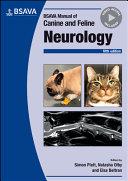BSAVA Manual of Canine and Feline Neurology 5 edition

Mnoho veterinárních lékařů považuje neurologii za jednu z nejobtížnějších specializací, přesto je to oblast, která prostě vyžaduje logický a systematický přístup. Nejnovější vydání této oblíbené příručky bylo důkladně přepracováno a aktualizováno, přičemž byl zachován praktický důraz na usnadnění vyhledávání informací.
V první části této příručky se popisuje zvyšující se dostupnost dalších diagnostických testů, jako je MRI, což značně pokročilo v této disciplíně, ale to nijak nesnižuje význam „neurologického vyšetření“. DVD obsažené v této nové edici obsahuje 100 videoklipů.
Druhá část o prezentaci neurologických případů poskytuje vynikající referenční text pokrývající různé příznaky a symptomy neurologických stavů, včetně nové kapitoly o genetických postiženích.
Třetí část zahrnuje aktuální informace o terapeutických možnostech, které budou užitečné pro veterinární lékaře specializující se na psy a kočky.
Autor: Simon Platt (Editor) , Natasha Olby (Editor) , Elsa Beltran (Editor)
| Nakladatel | British Small Animal Veterinary Association |
|---|---|
| ISBN | 9781910443835 |
| Vydání | V. vydání 2024 |
| Vazba | brožovaná |
| Počet stran | 550 |
Many veterinary practitioners consider neurology to be one of the more difficult specialties, yet it is an area that just requires a logical and systematic approach. The latest edition of this popular Manual has been thoroughly overhauled and updated, while retaining the practical emphasis to aid information retrieval. Part 1 of this Manual describes the increasing availability of additional diagnostic tests such as MRI, which has greatly advanced this discipline but this does not devalue the importance of “the neurological examination”. DVD contained in this new edition features 100 videoclips as the one shown left. This example shows positional strabismus: A dog exhibiting a right-sided positional strabismus suggestive of ipsilateral vestibular disease. As the head is moved a variable positional nystagmus is seen, which has a fast phase to the left when horizontal, compatible with right-sided disease. (See page 195 in the Manual).
Part 2 on neurological presentations provides an excellent reference text covering the diverse signs and symptoms of neurological conditions, including a new chapter on genetic diseases, and will be as well thumbed as the previous edition. Part 3 provides fully up to date coverage of therapeutic options that will be useful for all levels of veterinary surgeons.